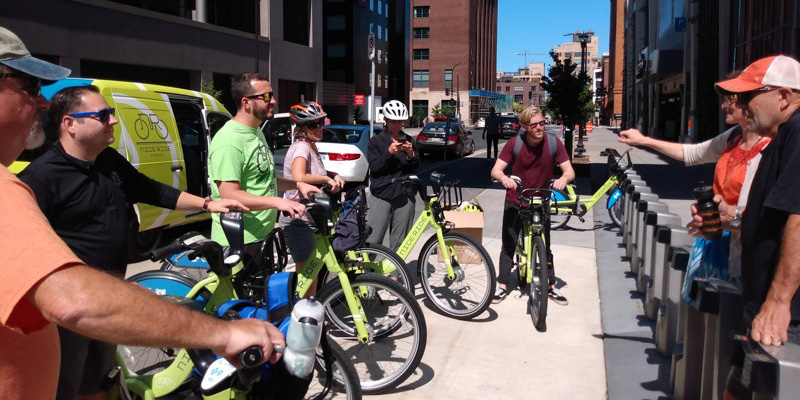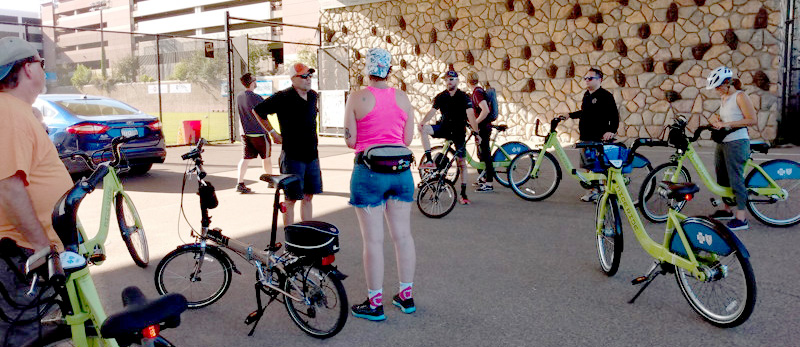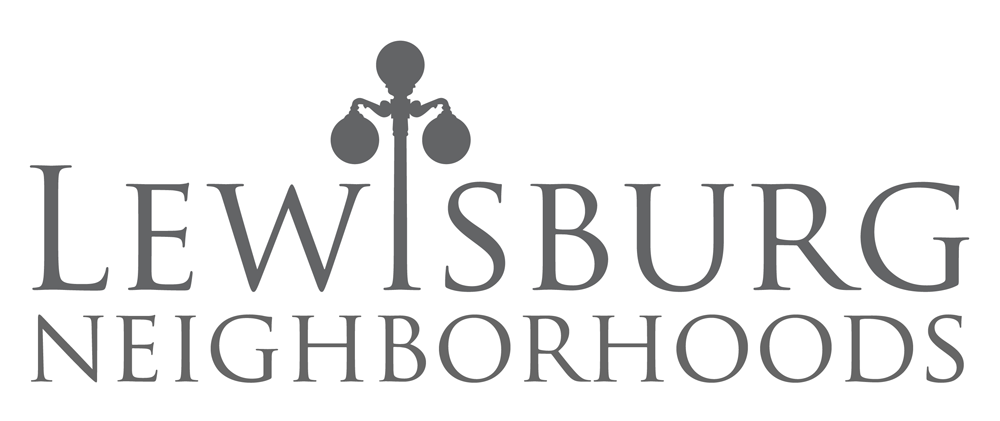Bicycle Infrastructure Best Practices Tour -- Minneapolis and St. Paul

At the end of August 2019, Bicycle South Central PA sent a group of people to Minneapolis, MN for a Bicycle Infrastructure Best Practices Tour led by a representative from Quality Bicycle Parts (QBP). The goal of the tour was to provide a fast but deep dive into a regional culture in which bicycle and pedestrian planning and advocacy are second nature. It showed how a Complete Streets mindset can lead to the creation of a bicycle transportation network that is accessible and welcoming for a large portion of the population. The resulting bicycle transportation system is used by people of all ages and (almost) all abilities, rather than being the exclusive realm of the daring or foolhardy. And perhaps even more importantly more people in the community, including both those who ride bikes and those who don’t, recognize the benefits of Active Transportation not just in terms of personal safety, but also as economic benefits (particularly lowered health care costs and greater business competitiveness).
The site visit entailed riding 45 miles on Nice Ride bike share bikes, providing first-hand experience with a wide range of bike infrastructure typologies, from off-road trails and rail trails to bike lanes of varying descriptions to cycletracks. The group saw how all modes of transportation were accommodated in a variety of settings, whether crossing the Mississippi River, navigating downtown, or traversing a campus or a neighborhood. The visitors also got to interact with different signage and traffic signals, road surfaces and paving techniques, and street furniture from bike parking to demountable curbs to bike counters. The series of rides was punctuated with meetings with people in organizations and public positions connected with bicycle advocacy, planning, and project implementation.

The tour attendees were all spurred to take part because of their involvement in planning and advocacy for bicycles in South and Central PA, whether from the government or non-profit sides. Not everyone in the group was an experienced cyclist and the intensity of the riding was somewhat challenging but thanks to the accessible network, all were able to do it.
The Q&A sessions were with representatives from the following organizations:
- Nice Ride Bike Share
- Our Streets Minneapolis
- City of Minneapolis Public Works, Bicycle and Pedestrian Division
- Hennepin County Bike/Ped Planning
- City of St. Paul Transportation Planning
- Bicycle Alliance of MN
- University of Minnesota Bike Center
- Midtown Greenway
Topics covered included the details of running programs and finding funding, kids’ education initiatives and trainings available to public school teachers and municipal employees, neighborhood planning dynamics, city-wide strategies and initiatives, Bicycle-Friendly Businesses, and statewide work. The fact that MN has headed off their obesity trajectory got top billing. They see Active Transportation as a key element in that high stakes effort to reduce health risks.
The city and its partners showcased their comprehensive commitment to cycling and to Complete Streets as an ethos. The starting assumption is that streets are for everybody and all parties are working towards the best implementation options as infrastructure is maintained, replaced, or improved over time. Rather than asking whether to incorporate bike and pedestrian infrastructure elements in a given project, it is simply a question of which elements and how to do the best job with it. In other words, the community addresses the question “what should this bike lane and sidewalk look like?” not “should there be a bike lane or sidewalk here?”
Minneapolis has quite generous street proportions, with a decidedly Midwestern feel to the public spaces, something that even neighboring St. Paul struggles with more. However, in spite of a potentially fraught road funding system, one which docks all adjacent property owners for a significant portion of street reconstruction funds, they also have an attitude of simply doing what must be done. It can hardly be said that Minneapolis is a cycling paradise given the severity of the climate. But even that gives them a chance to shine, demonstrating how bike infrastructure is compatible with snow emergency routes and highlighting their commitment to winter maintenance (snow and ice removal) on bike/ped infrastructure throughout the year.

Even very small communities in the state far away from the Twin Cities are also committed to the benefits of Active Transportation both for residents’ personal health and also for economic benefits. They know that being a Bike-Friendly Community (per the League of American Bicyclists program) shows they are committed to local quality of life and makes their local economies and businesses more marketable and better at recruiting talent. In fact, the municipality with the highest proportion of Bike-Friendly Businesses in the country on a per capita basis is a small town in Northern MN called Walker, with a grand total of 941 residents!
Having this first-hand, helmets-on experience was incredibly helpful in revealing details, for example about techniques for preserving road markings from the impact of snow plows, and in sharing a glimpse of what a comprehensively bike-friendly environment can do for an afternoon rush hour. Tour participants brought their own interest in and perspective on bike advocacy, but a similar tour could also provide a great introduction for people with less familiarity with the topic. The real key is helping people understand
- that these improvements help all transportation modes as well as the bottom line across the board in the community,
- that they do not represent special treatment for a small subset of the population, but rather are open to all who choose to engage with them, and
- that by making them truly inviting and safe, the number of those who may so engage increases dramatically.
Minneapolis (and Minnesota at large) is a living, thriving example of the rewards that can accrue to communities that commit to Complete Streets. Their official modal priority framework prioritizes right-of-way use first for walking, then for biking and taking transit, and then for driving personal vehicles. They have achieved Gold Level recognition both as a Walk Friendly Community by the Pedestrian and Bicycle Information Center and as a Bicycle Friendly Community by the League of American Bicyclists. The result is a sight to see! And you don’t have to go to Scandinavia to experience it – it’s a true American dream!

Visit bit.ly/MNbikeinfrapix2019 for additional notes, maps, and images.

